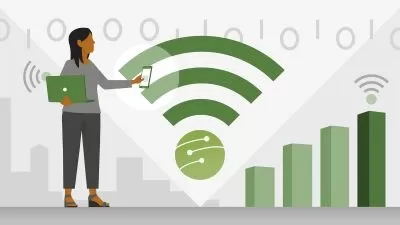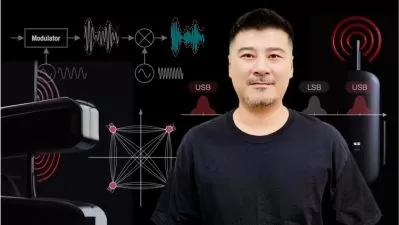6G, 5G, 4G, 3G, 2G Telecom Technologies - Foundation
Rahul kaundal
5:28:40
Description
Telecom Network Overview, Architecture Evolution, Radio Access, Transport & Core Network, Call Flows, Future of Telecom
What You'll Learn?
- Telecom Network Overview - 2G, 3G, 4G, 5G, 6G
- Technology & Architecture Evolution - 2G to 6G
- Radio Access Network - 4G , 5G
- Radio Access Network Evolution
- Transport Network
- Core Network - 4G, 5G
- Call Flows
- Future of Telecom
Who is this for?
What You Need to Know?
More details
DescriptionLet's dive into the world of telecom networks, starting from square one. No need for tedious jargon about 2G, 3G, 4G, or 5G - we'll keep it simple and fun!
Section 1. Telecom Network Overview
•Evolution of telecom technologies from 2G to 5G
•Standards & Specifications by 3GPP & ITU
•Telecom Network Architecture
•What is Telecom Mast
•Different Types of Masts/Cells
•Different Types of Antennas
•What is User Equipment
•Radio Access Network
•Transport Network
•Core Network
As technology evolves, so does its incredible architecture. Witness the magic of fewer nodes required to do the same job, and the mind-bending capabilities of emerging tech.
Section 2. Technology & Architecture Evolution
•Telecom Network Architecture
•2G-GSM Network Architecture
•3G-UMTS Network Architecture
•4G-LTE Network Architecture
•5G Network Architecture
•IP Multimedia Subsystem (IMS)
•4G Key Capabilities
•5G Key Capabilities
Let's talk RAN, the key part of telecommunication network. It's no secret that RAN eats up nearly 60-70% of spending on the tech front, so it's high time we learn up on the key terms.
Section 3. Radio Access Network - Air Interface
•4G & 5G Spectrum
•Duplex Schemes
•4G & 5G Frame Structure
•5G Frame Structure
•Modulation and coding
•OFDMA
•Timing Advance
•Power Control
•Carrier Aggregation
Antenna Basics, MIMO & Beamforming
After understanding the basics of Radio Access Network (RAN), let’s nail down different ways to boost efficiency and transition it to commercial-off-the-shelf hardware and cloud architecture to create value.
Section 4. Radio Access Network Evolution
•Stages of RAN Evolution
•Split Architecture - RAN
•Virtualization in RAN & How Virtualization works
•Cloud RAN & How Cloud RAN works
•Deployment scenarios – RAN
•Origin of Open RAN
•What is Open RAN?
•Open RAN Standards
Open RAN design goals & Challenges
To ensure seamless communication among users in the network, all nodes are linked back to the core network. But wait, there's more than one way to connect these nodes! So, let's dig into the nitty-gritty.
Section 5. Transport Network
•Transport Network Architecture
•Transport Network Topology
•Evolution in Transport Network
•CIPRI & eCIPRI
•Frequency bands for Transport Network
•Options to achieve high capacity (throughput) in 5G
•E-band : Capacity Vs Availability
•E-band : Latency
•Service Level Architecture
Meet the superhero subnetwork: Core Network! It's the subnetwork that connects with external data networks and other PLMNs, making sure users get access to all the services they need. Get ready to learn about the key nodes and their functions, and how this network is transforming into its virtual form.
Section 6. Core Network
•4G Core Network Architecture & Nodes
•4G MME, SGW, PGW, HSS & PCRF
•5G Core Network Architecture & Nodes
•5G AMF, SMF, UPF, PCF, UDM, NWDAF, NSSAI & NRF
Tech's got its own quirky ways of letting users hop onto the network. Let’s dive into the call flow for initial access and registration, where radio and core network components exchange a flurry of messages.
Section 7. Call flows & Inter-System working
•Registration Procedures
•4G & 5G – Initial access & Registration
•Network Identity - 4G/5G – Cell Identifier & Physical Cell Id
•User Identity - IMSI, GUTI, SUPI & SUCI
•Inter-working between different Technologies
Telecom is evolving continuously and new techniques such as Virtualization, Cloud Computing, Software defined networking are helping in achieving more agile and efficient networks.
Section 8. Future of Telecom
·6G Technology
·Virtualization
·Types of Virtualization
·Network Function Virtualization (NFV) & Orchestration
·Software Defined Networking (SDN)
·Cloud Computing
·Types of Cloud Computing
·Telco Cloud
Who this course is for:
- Suitable for beginners who are interested to get into telecom domain and learn all telecom technologies
- Refresher for those who are already working in telecom domain
Let's dive into the world of telecom networks, starting from square one. No need for tedious jargon about 2G, 3G, 4G, or 5G - we'll keep it simple and fun!
Section 1. Telecom Network Overview
•Evolution of telecom technologies from 2G to 5G
•Standards & Specifications by 3GPP & ITU
•Telecom Network Architecture
•What is Telecom Mast
•Different Types of Masts/Cells
•Different Types of Antennas
•What is User Equipment
•Radio Access Network
•Transport Network
•Core Network
As technology evolves, so does its incredible architecture. Witness the magic of fewer nodes required to do the same job, and the mind-bending capabilities of emerging tech.
Section 2. Technology & Architecture Evolution
•Telecom Network Architecture
•2G-GSM Network Architecture
•3G-UMTS Network Architecture
•4G-LTE Network Architecture
•5G Network Architecture
•IP Multimedia Subsystem (IMS)
•4G Key Capabilities
•5G Key Capabilities
Let's talk RAN, the key part of telecommunication network. It's no secret that RAN eats up nearly 60-70% of spending on the tech front, so it's high time we learn up on the key terms.
Section 3. Radio Access Network - Air Interface
•4G & 5G Spectrum
•Duplex Schemes
•4G & 5G Frame Structure
•5G Frame Structure
•Modulation and coding
•OFDMA
•Timing Advance
•Power Control
•Carrier Aggregation
Antenna Basics, MIMO & Beamforming
After understanding the basics of Radio Access Network (RAN), let’s nail down different ways to boost efficiency and transition it to commercial-off-the-shelf hardware and cloud architecture to create value.
Section 4. Radio Access Network Evolution
•Stages of RAN Evolution
•Split Architecture - RAN
•Virtualization in RAN & How Virtualization works
•Cloud RAN & How Cloud RAN works
•Deployment scenarios – RAN
•Origin of Open RAN
•What is Open RAN?
•Open RAN Standards
Open RAN design goals & Challenges
To ensure seamless communication among users in the network, all nodes are linked back to the core network. But wait, there's more than one way to connect these nodes! So, let's dig into the nitty-gritty.
Section 5. Transport Network
•Transport Network Architecture
•Transport Network Topology
•Evolution in Transport Network
•CIPRI & eCIPRI
•Frequency bands for Transport Network
•Options to achieve high capacity (throughput) in 5G
•E-band : Capacity Vs Availability
•E-band : Latency
•Service Level Architecture
Meet the superhero subnetwork: Core Network! It's the subnetwork that connects with external data networks and other PLMNs, making sure users get access to all the services they need. Get ready to learn about the key nodes and their functions, and how this network is transforming into its virtual form.
Section 6. Core Network
•4G Core Network Architecture & Nodes
•4G MME, SGW, PGW, HSS & PCRF
•5G Core Network Architecture & Nodes
•5G AMF, SMF, UPF, PCF, UDM, NWDAF, NSSAI & NRF
Tech's got its own quirky ways of letting users hop onto the network. Let’s dive into the call flow for initial access and registration, where radio and core network components exchange a flurry of messages.
Section 7. Call flows & Inter-System working
•Registration Procedures
•4G & 5G – Initial access & Registration
•Network Identity - 4G/5G – Cell Identifier & Physical Cell Id
•User Identity - IMSI, GUTI, SUPI & SUCI
•Inter-working between different Technologies
Telecom is evolving continuously and new techniques such as Virtualization, Cloud Computing, Software defined networking are helping in achieving more agile and efficient networks.
Section 8. Future of Telecom
·6G Technology
·Virtualization
·Types of Virtualization
·Network Function Virtualization (NFV) & Orchestration
·Software Defined Networking (SDN)
·Cloud Computing
·Types of Cloud Computing
·Telco Cloud
Who this course is for:
- Suitable for beginners who are interested to get into telecom domain and learn all telecom technologies
- Refresher for those who are already working in telecom domain
User Reviews
Rating
Rahul kaundal
Instructor's Courses
Udemy
View courses Udemy- language english
- Training sessions 115
- duration 5:28:40
- Release Date 2024/02/09











